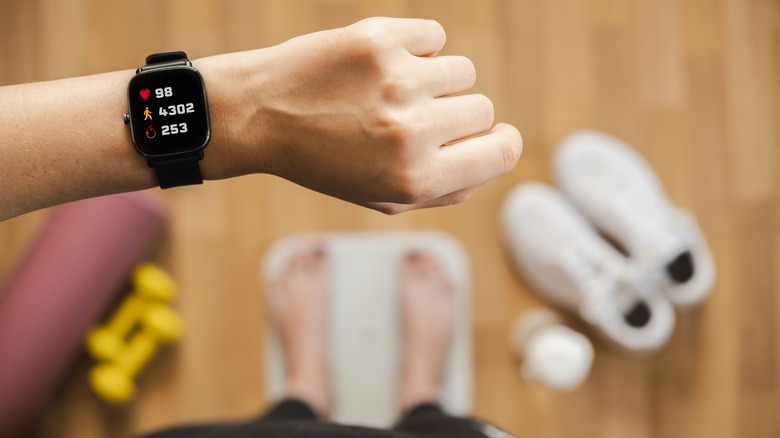This Is The Typical Amount Of Steps Most People Take During The Day
Setting daily step goals has become a popular way for people to track and improve their health thanks to the help of pedometers — portable devices that can measure daily physical activity (Via NCHPAD). Nowadays, tracking your steps is easier than ever with pedometers built into smartwatches like the FitBit and the Apple Watch. According to Fitness 19, "Step trackers encourage personal and/or community accountability" and promote healthy, active lifestyles. Getting your steps in is super important: Studies have shown links between sitting for long periods of time during the day and poor health, per Advisory Board. Implementing and tracking a low-intensity activity as simple as walking can lead to an overall healthier lifestyle.
10,000 steps is the daily goal that most people strive to achieve. Once you reach 10,000 steps, your Apple Watch cheers. Congrats, you've hit your daily goal! But how often do people actually hear their Apple watch celebrate? A survey conducted by The List asked 573 people, "How many steps do you typically get in a day?" The results had us checking our own step trackers to see how we measure up.
Most people don't hit 10,000 daily steps
With people still working from home and the current heat wave blazing on, we don't judge anyone for their step count. But we were curious to know how many steps people walk during a typical day. According to The List's survey results, nearly 35% of people reported they get an average of 1000-5000 daily steps. Another 28.45% said they achieve a 5,000-10,000 step goal every day; only about 12% reported achieving up to 15,000 steps, and only 4.71% reached 15,000 or more per day. Some people reported that they get less steps. Almost 13% of people's daily step count ranged between 500-1000, and 7.68% admitted to walking less than 500 steps per day.
The results cover a wide range, and it might seem discouraging that most people do not achieve that 10,000 steps per day goal. But according to Insider, that goal is actually due to capitalism, not health. Daniel Lieberman, author of "Exercised," reported that the concept of 10,000 steps dated back to the 1960s when a Japanese company, Yamasa Tokei, sold the first pedometer. They called it the "10,000-steps meter" because it "sounded good." Healthline reported that the number of steps in your goal doesn't matter nearly as much as the goal of moving more throughout the day.
Your career might impact the amount of steps you take
Flushing Hospital Medical Center reported that a person's career and commute can be the difference between 5,000 and 10,000 steps each day. People with office jobs and longer drives to and from work are at greater risk of health problems because of their lack of physical activity during the day. Those with physically demanding jobs who can walk or take public transportation to work will see a higher step count each day. We're not saying it's time to quit your day job, but those with less active daily routines might want to make a conscious effort to seek more physical activities outside of their 9 to 5.
Mayo Clinic provided examples of low-intensity activities for those of us who want to earn a few extra steps throughout the day. Taking your dog for a walk is one of the best ways to get your steps in. As an added bonus, you're keeping your furry friend happy as you enjoy some fresh air. Taking a walk with your date at a local park or an easy hiking trail is another option. Even simple lifestyle changes like taking the stairs and parking far away from your destination can encourage a more active daily routine. One tip we love to share: Treat yourself to cute new shoes and work on breaking them in around the house. You'll be amazed at how many steps you get in, and you're left with comfy new shoes!


